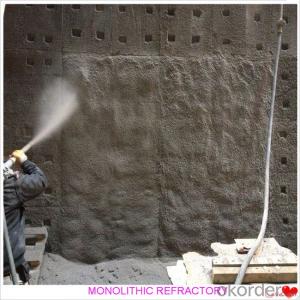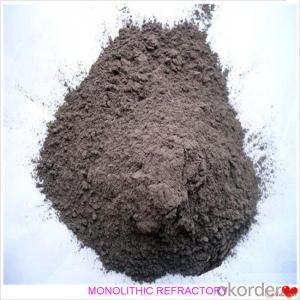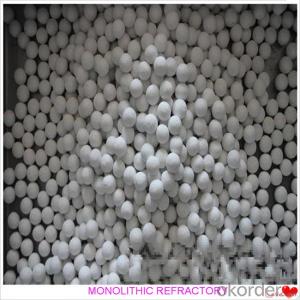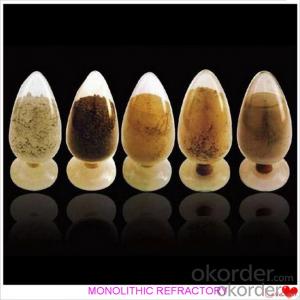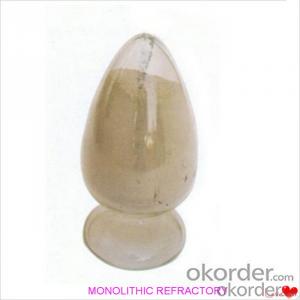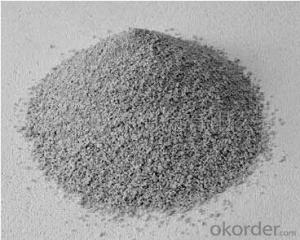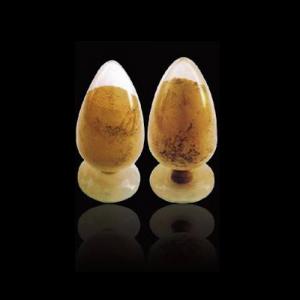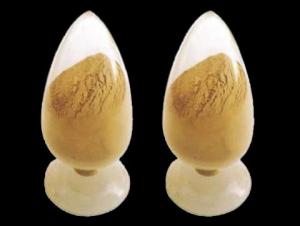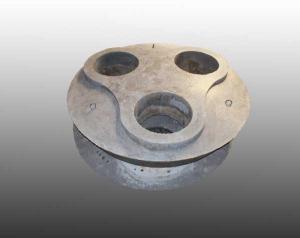Portlant Cement Castable For Fireplace and Industrial Furnace
- Loading Port:
- China main port
- Payment Terms:
- TT or LC
- Min Order Qty:
- 1000 kg
- Supply Capability:
- 3000000 kg/month
OKorder Service Pledge
OKorder Financial Service
You Might Also Like
Portland Cement Castable for Fireplaces and Industrial Furnaces
Product Description:
Portland cement castable is manufactured according to international standards. The product is famous for its excellent abrasion resistance and low thermal conductivity. Further, these can be provided in different specifications as required by clients. Castables use high purity raw materials and additives as the main material, and are made with superfine powder adding technology.
Product Features:
The material has excellent structural stability and air tightness, and has high physical and chemical properties, and also excellent working ability. If should be used with the same material products.
Product Applications:
Widely used in various kiln linings, such as boilers, blast furnace hot blast stoves, heating furnaces, ceramic kilns, heat treatment furnaces, incinerators, re-circulating fluidized bed furnaces and chemical industry and construction industry furnaces.
Product Specifications:
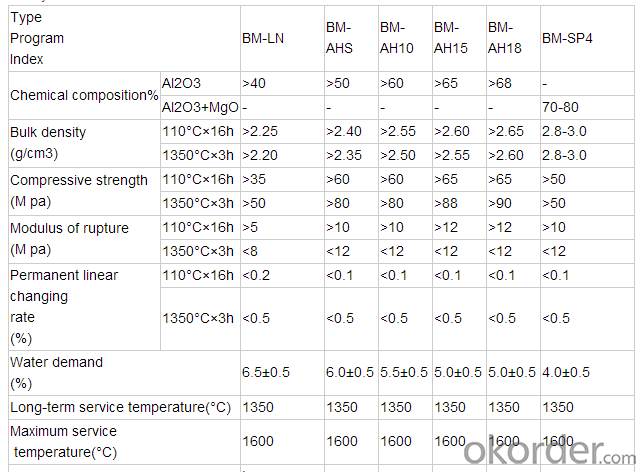
Product Images:
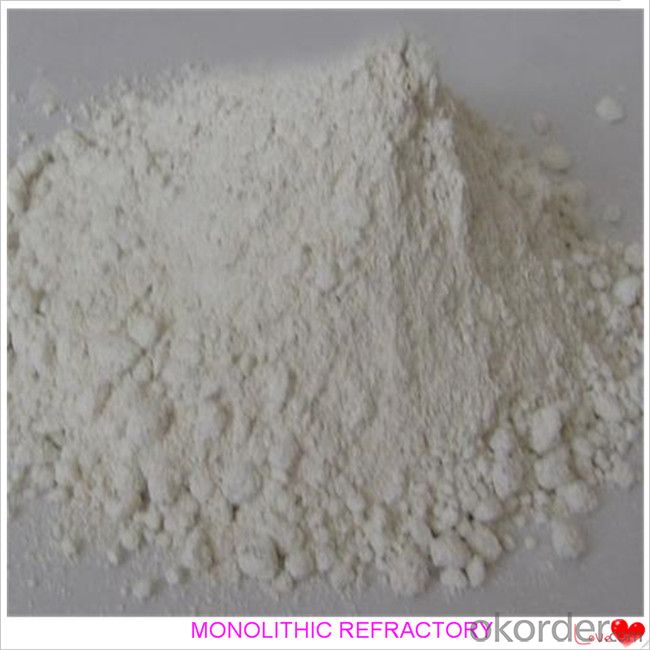
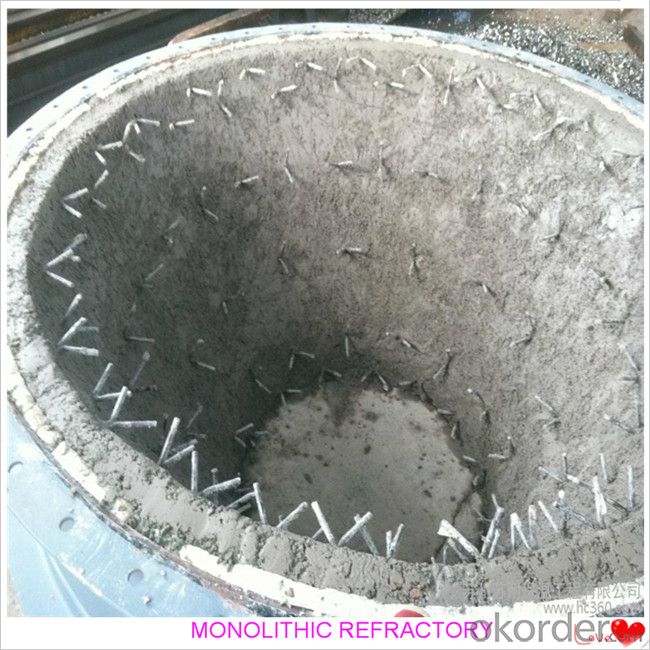
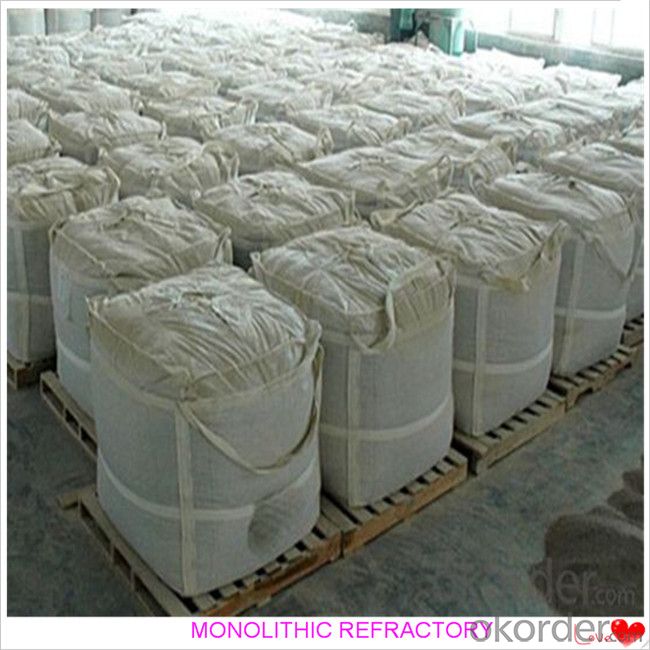
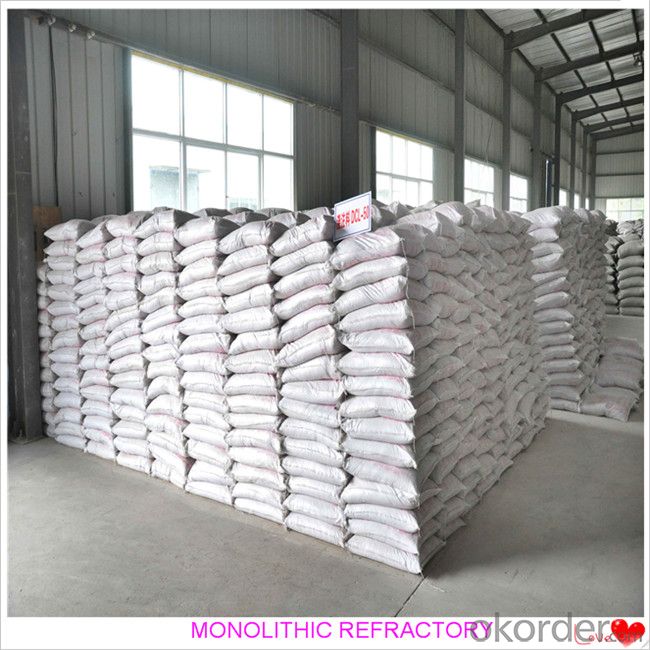
FAQ:
Q1: Why buy Materials & Equipment from OKorder.com?
A1: All products offered by OKorder.com are carefully selected from China's most reliable manufacturing enterprises. Through its ISO certifications, OKorder.com adheres to the highest standards and a commitment to supply chain safety and customer satisfaction.
Q2: How do we guarantee the quality of our products?
A2: We have established an advanced quality management system which conducts strict quality tests at every step, from raw materials to the final product. At the same time, we provide extensive follow-up service assurances as required.
- Q:What are the factors to consider when selecting monolithic refractories for specific applications?
- When selecting monolithic refractories for specific applications, there are several factors that need to be considered. These factors include the operating temperature, chemical environment, mechanical stress, and the desired performance characteristics of the refractory material. The operating temperature is a crucial factor to consider as different monolithic refractories have different temperature limits. It is important to choose a refractory material that can withstand the specific temperature range of the application without suffering from thermal spalling or degradation. The chemical environment in which the refractory will be exposed is another crucial factor. Different applications may involve exposure to various chemicals, acids, alkalis, or gases. It is essential to select a monolithic refractory that is chemically resistant to the specific environment to ensure prolonged durability and performance. Mechanical stress is also an important consideration when selecting monolithic refractories. Some applications may involve high mechanical stress such as abrasion, impact, or thermal shock. It is crucial to choose a refractory material that can withstand these stresses without cracking or failure. The desired performance characteristics of the refractory material should also be taken into account. This includes factors such as thermal conductivity, thermal expansion, density, and strength. The application requirements will dictate the specific performance characteristics needed, and the refractory material should be chosen accordingly. Other factors to consider include installation method, availability, cost, and maintenance requirements. Some monolithic refractories may require specialized installation techniques, while others may be more readily available and cost-effective. Additionally, the maintenance requirements of the refractory material should be considered to ensure ease of upkeep and longevity. Overall, selecting the right monolithic refractories for specific applications requires careful consideration of factors such as operating temperature, chemical environment, mechanical stress, desired performance characteristics, installation method, availability, cost, and maintenance requirements. By considering these factors, one can choose the most suitable refractory material that will provide optimal performance and durability in the given application.
- Q:How are monolithic refractories applied in the hot face and cold face of furnace linings?
- Because of their superior thermal and mechanical properties, monolithic refractories are commonly utilized in furnace linings. These materials are employed in both the hot face and cold face of furnace linings, but their application methods differ for each. When it comes to the hot face of furnace linings, monolithic refractories are applied to endure extreme temperatures and harsh conditions. This area directly faces the heat source and is exposed to the highest temperatures. In this region, the refractory material is specifically engineered to possess excellent thermal conductivity and high resistance to thermal shock. To apply monolithic refractories in the hot face, the commonly used technique is gunning. Gunning involves the spraying or troweling of the refractory material onto the lining's surface. This technique enables quick and efficient application, ensuring a uniform and dense layer of refractory material. Gunning is especially suitable for areas with intricate shapes and contours. On the other hand, the primary concern for the cold face of furnace linings is insulation and protection. The cold face refers to the area that does not directly come into contact with the heat source and experiences lower temperatures. In this area, the refractory material is designed to possess low thermal conductivity and high insulation properties. The application of monolithic refractories in the cold face is typically accomplished using the technique called ramming. Ramming involves compacting the refractory material into place using a pneumatic or hydraulic ramming tool. This technique ensures the creation of a dense and solid layer of refractory material, providing excellent insulation and protection against heat loss. In conclusion, monolithic refractories are vital components of furnace linings as they provide the necessary thermal insulation and mechanical strength required in high-temperature environments. The application techniques of gunning and ramming allow for efficient and effective installation in both the hot face and cold face of furnace linings.
- Q:What are the factors influencing the choice of monolithic refractories for different furnace types?
- The choice of monolithic refractories for different furnace types is influenced by various factors that need to be considered in order to ensure optimal performance and efficiency. These factors include the operating temperature, type of heat transfer mechanism, chemical composition of the furnace atmosphere, thermal cycling, mechanical stresses, and specific application requirements. One of the primary factors to consider is the operating temperature of the furnace. Different monolithic refractories have different temperature limits, and it is crucial to select a refractory material that can withstand the specific temperature range of the furnace without significant degradation or failure. For high-temperature applications, materials like alumina, magnesia, and silica are commonly used due to their excellent thermal stability. The type of heat transfer mechanism is another important consideration. Furnaces can use various methods to transfer heat, such as radiation, conduction, or convection. Each of these mechanisms may require different refractory properties. For example, radiation-dominated furnaces may require a refractory material with high thermal conductivity to efficiently transfer heat, while convection-dominated furnaces may require a material with good resistance to gas flow erosion. The chemical composition of the furnace atmosphere is also a crucial factor. Depending on the process being carried out in the furnace, the atmosphere may contain highly corrosive gases or chemicals. In such cases, it is essential to select a monolithic refractory that is resistant to chemical attack and can maintain its structural integrity in the presence of aggressive substances. Thermal cycling, which involves repeated heating and cooling cycles, is another factor influencing the choice of monolithic refractories. Some refractory materials may be prone to thermal shock or spalling when subjected to rapid temperature changes. In contrast, others may have better resistance to thermal cycling, making them more suitable for applications that involve frequent temperature variations. Mechanical stresses, such as load or vibration, can also impact the choice of refractories. Furnaces that experience mechanical stresses require materials with good mechanical strength and resistance to abrasion. Refractory materials like silicon carbide or zirconia may be preferred in such cases due to their high strength and toughness. Lastly, specific application requirements should be considered when selecting monolithic refractories. Factors such as installation method, ease of maintenance, availability, and cost-effectiveness may influence the choice of refractory material. In summary, the choice of monolithic refractories for different furnace types is influenced by the operating temperature, heat transfer mechanism, chemical composition of the furnace atmosphere, thermal cycling, mechanical stresses, and specific application requirements. Considering these factors is essential to ensure the longevity, performance, and efficiency of the refractory lining in various furnace applications.
- Q:What are the typical operating temperatures for monolithic refractories?
- The typical operating temperatures for monolithic refractories vary depending on the specific composition and type of refractory material. However, in general, monolithic refractories are designed to withstand high temperatures ranging from 1500°C (2732°F) to 1800°C (3272°F) and even higher in some cases. These refractories are commonly used in industries such as steelmaking, cement production, glass manufacturing, and petrochemical processing, where they are subjected to extreme thermal conditions. Different types of monolithic refractories have different temperature limits. For instance, basic refractories made of magnesia or dolomite can withstand temperatures up to 1800°C (3272°F). On the other hand, alumina-based refractories can typically handle temperatures up to 1700°C (3092°F). Silicon carbide-based refractories have even higher temperature resistance, with the ability to withstand temperatures above 2000°C (3632°F). It is crucial to select the appropriate monolithic refractory material based on the specific operating temperature requirements of the application. Using refractories beyond their recommended temperature limits can cause thermal shock, spalling, or reduced performance, leading to potential equipment failure or safety hazards. Therefore, consulting with refractory manufacturers or experts in the field is essential to ensure the correct selection and optimal performance of monolithic refractories in high-temperature applications.
- Q:How do monolithic refractories improve the efficiency of ladle and tundish preheating stations?
- Monolithic refractories play a crucial role in enhancing the efficiency of ladle and tundish preheating stations. These refractories are specifically designed to withstand high temperatures and thermal shocks, making them ideal for use in preheating applications. One key way in which monolithic refractories improve efficiency is by providing excellent heat insulation. These refractories have low thermal conductivity, meaning they minimize heat loss from the preheating station to the surroundings. As a result, more heat is retained within the ladle or tundish preheating station, leading to faster and more efficient heating of the vessel. Additionally, monolithic refractories offer superior heat retention properties. Once heated, these refractories have the ability to store and release heat gradually over time. This characteristic allows for a more consistent and controlled heating process in the ladle or tundish preheating station. By maintaining a stable temperature, the refractories ensure that the vessel is heated uniformly and prevent thermal shocks that could lead to cracking or other damage. Furthermore, monolithic refractories have excellent resistance to chemical reactions and erosion caused by molten metals and slag. Ladles and tundishes are often exposed to corrosive environments, and the use of monolithic refractories helps to protect against degradation and extend the lifespan of the preheating station. This durability reduces the need for frequent maintenance and replacement, leading to cost savings and improved overall efficiency. In summary, monolithic refractories improve the efficiency of ladle and tundish preheating stations by providing excellent heat insulation, heat retention, and resistance to chemical reactions. These properties result in faster and more uniform heating, reduced heat loss, and increased durability of the preheating station. Ultimately, these benefits contribute to improved productivity and cost-effectiveness in the steelmaking process.
- Q:How are monolithic refractories used in the iron and steel industry?
- Due to their exceptional performance and versatility, monolithic refractories are widely utilized in various applications within the iron and steel industry. Composed of a uniform material, these refractories serve as seamless linings in high-temperature environments. In the iron and steel industry, the significance of monolithic refractories cannot be overstated as they play a crucial role in multiple stages of the manufacturing process. A primary application is seen in the blast furnace, where the inside of the furnace is lined with monolithic refractories. This lining is exposed to exceedingly high temperatures and harsh chemical reactions. By providing excellent thermal insulation and resistance to chemical attack, monolithic refractories ensure the durability and longevity of the blast furnace. Another crucial application is witnessed in the steelmaking process, where monolithic refractories are used to line the ladles and tundish, utilized for transporting and pouring molten steel. These refractories are specially designed to withstand the corrosive nature and high temperatures of the molten steel, thus preventing contamination and guaranteeing the quality of the final product. Furthermore, monolithic refractories find application in various ancillary equipment and structures within the iron and steel industry. They are employed in furnaces, kilns, and other heat treatment systems to provide insulation and maintain high-temperature conditions. Additionally, they are used in the construction of chimneys, exhaust ducts, and other exhaust systems, where they offer thermal insulation and resistance against corrosive gases. Overall, the vital role played by monolithic refractories in the iron and steel industry lies in their ability to provide high-temperature insulation, chemical resistance, and durability. They optimize the production process, enhance energy efficiency, and ensure the quality of the final product. With their exceptional performance and versatility, monolithic refractories have become an indispensable component within the iron and steel manufacturing industry.
- Q:How do monolithic refractories resist thermal shock in the iron and steel industry?
- Monolithic refractories are specifically designed to resist thermal shock in the iron and steel industry. This is primarily achieved through their unique composition and structure. Firstly, monolithic refractories are made from high-quality raw materials, such as alumina, magnesia, and silica, which have excellent thermal properties. These materials are carefully selected to provide a high melting point, low thermal conductivity, and good thermal expansion characteristics. Secondly, the manufacturing process of monolithic refractories involves precise control of the grain size distribution and the addition of bonding agents. This results in a dense and homogeneous structure, which enhances their resistance to thermal shock. The bonding agents also play a crucial role in enhancing the refractory's strength and integrity. Additionally, monolithic refractories are often formulated with additives that provide increased resistance to thermal shock. These additives can include zirconia, silicon carbide, or graphite, which improve the refractory's ability to withstand rapid temperature changes. Moreover, monolithic refractories are designed to have low porosity, reducing the penetration of molten metal or slag into the material. This helps to prevent the formation of cracks and spalling, which can occur due to thermal shock. Furthermore, monolithic refractories are often applied as a lining or coating on the surface of the furnace or other equipment. This allows them to form a protective barrier, reducing direct exposure to extreme temperatures and thermal cycling. Overall, the combination of high-quality raw materials, careful manufacturing processes, additives, low porosity, and proper application techniques make monolithic refractories highly resistant to thermal shock in the iron and steel industry. They can withstand rapid temperature changes, prevent cracks, and maintain their structural integrity, ensuring reliable and efficient operation of furnaces and other equipment in this demanding industry.
- Q:How do monolithic refractories help in improving the quality of iron and steel products?
- Monolithic refractories play a crucial role in improving the quality of iron and steel products in several ways. Firstly, these refractories are used to line the furnaces and other high-temperature equipment in the iron and steel industry. By providing a high level of thermal insulation, monolithic refractories help maintain a consistent and controlled temperature inside the furnace, ensuring efficient heating and melting of metals. The use of monolithic refractories also helps in reducing heat loss, thereby increasing the energy efficiency of the process. This not only saves costs but also minimizes the environmental impact associated with high energy consumption. Additionally, the insulation properties of monolithic refractories contribute to the reduction of thermal stresses within the furnace, preventing cracks and other structural damages that can affect the quality of the iron and steel products. Moreover, monolithic refractories possess excellent resistance to chemical reactions, corrosion, and erosion caused by molten metals, slag, and other harsh substances. This resistance helps to maintain the integrity of the refractory lining, preventing contamination of the iron and steel products by unwanted impurities. As a result, the quality of the final products, such as steel bars, sheets, or pipes, is improved, meeting the desired specifications and industry standards. Another advantage of monolithic refractories is their ability to provide a smooth and clean lining surface. This smoothness minimizes the adherence of slag, molten metal, and other by-products, reducing the risk of defects and ensuring a higher-quality finish for the iron and steel products. The clean lining surface also facilitates easy maintenance and cleaning, allowing for efficient and effective operations. In summary, monolithic refractories contribute significantly to the improvement of iron and steel product quality through their exceptional thermal insulation, resistance to chemical reactions, erosion, and corrosion, as well as their ability to provide a smooth and clean lining surface. By ensuring consistent temperatures, reducing heat loss, preventing structural damages, and maintaining a clean environment, monolithic refractories enhance the overall efficiency and integrity of the iron and steel production process, resulting in high-quality end products.
- Q:What are the different types of monolithic refractories used in the iron and steel industry?
- The iron and steel industry relies on various types of monolithic refractories for their exceptional thermal resistance, strength, and durability. These refractories are crucial in withstanding extreme temperatures and harsh conditions in a range of applications. Firstly, there are castables, which are precast refractory materials that form a slurry when mixed with water. This slurry is then poured or cast into molds. Castables are widely used in the iron and steel industry to line ladles, tundishes, and furnaces due to their high strength and resistance to thermal shock. Another type is ramming mass, which is used to line induction furnaces and melting units. It is composed of refractory aggregates, binders, and additives. Ramming mass is applied by ramming or tamping it into place, creating a dense lining capable of withstanding high temperatures and chemical attacks. Gunning mix is a refractory material applied using a pneumatic gunning machine. It is particularly useful for repairing or lining various areas of furnaces, especially during hot repairs. Gunning mix consists of refractory aggregates, binders, and additives that are sprayed onto the lining surface and then compacted. Plastic refractories, on the other hand, are mixtures of refractory aggregates and binders with high plasticity. They can be easily molded or shaped, making them ideal for repairing or patching refractory linings in the iron and steel industry. Plastic refractories are typically applied by hand or with a trowel and are suitable for both hot and cold applications. Lastly, refractory mortars are used for jointing or repairing refractory bricks or other monolithic refractories. They are composed of refractory powders, binders, and water. Mortars provide excellent adhesion between bricks or monolithic materials, ensuring a strong and durable lining in furnaces, ladles, and other high-temperature equipment. These various types of monolithic refractories are indispensable in the iron and steel industry. They provide reliable and long-lasting linings, ensuring efficient operations and minimizing downtime.
- Q:How are monolithic refractories repaired or replaced in iron and steel facilities?
- Monolithic refractories in iron and steel facilities are repaired or replaced through a process known as hot repair or hot gunning. This involves using specialized equipment to heat the damaged refractory material and remove it. The area is then prepared for new refractory installation, which is done by either shotcreting or gunning the new material onto the surface. This method allows for quick repairs and replacements, minimizing downtime and ensuring the efficiency and safety of the facility.
1. Manufacturer Overview |
|
|---|---|
| Location | |
| Year Established | |
| Annual Output Value | |
| Main Markets | |
| Company Certifications | |
2. Manufacturer Certificates |
|
|---|---|
| a) Certification Name | |
| Range | |
| Reference | |
| Validity Period | |
3. Manufacturer Capability |
|
|---|---|
| a)Trade Capacity | |
| Nearest Port | |
| Export Percentage | |
| No.of Employees in Trade Department | |
| Language Spoken: | |
| b)Factory Information | |
| Factory Size: | |
| No. of Production Lines | |
| Contract Manufacturing | |
| Product Price Range | |
Send your message to us
Portlant Cement Castable For Fireplace and Industrial Furnace
- Loading Port:
- China main port
- Payment Terms:
- TT or LC
- Min Order Qty:
- 1000 kg
- Supply Capability:
- 3000000 kg/month
OKorder Service Pledge
OKorder Financial Service
Similar products
New products
Hot products
Related keywords
